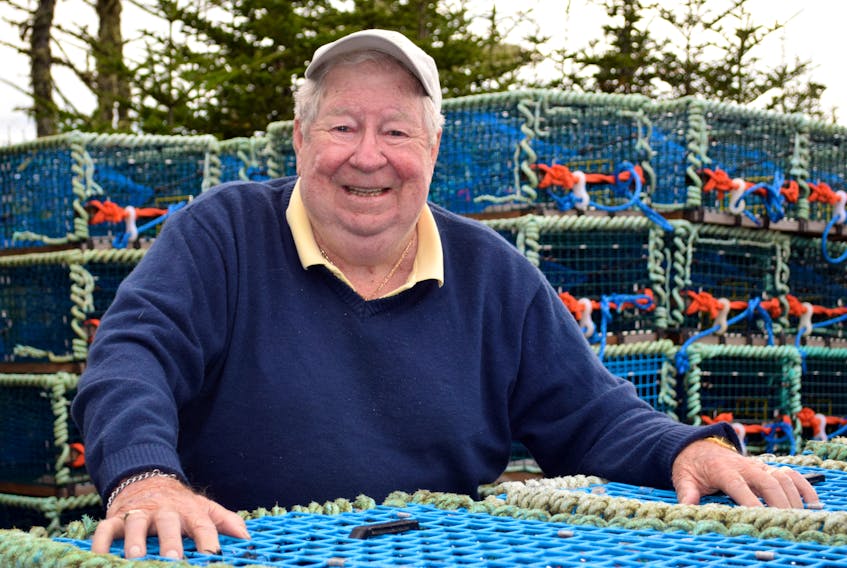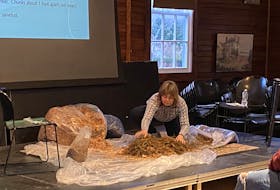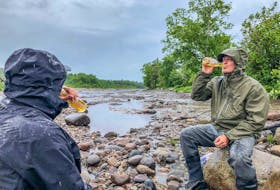CAPE SABLE ISLAND, NS – Bradford (Baffy) Symonds Jr. was only a-year-and-a-half old when his mother took him to Seal Island for the first time.
“I’ve pretty well been on the ocean every year since,” said the retired Cape Sable Island fisherman. “It’s been an interesting life.”
Symonds attended his first year of school on Seal Island in 1936.
“There were about 40 to 50 students,” he says, explaining the island fishermen all took their families there in November. “Some stayed all winter. We always came home.”
Bradford (Baffy) Symonds Jr. started lobster fishing when he was 12. Lobsters were 25 cents a pound, wages were $25 a week. His father couldn’t afford a hired man so he took him and his 15-year-old brother Herbert.
Symonds says his father Bradford Sr. was one of five lobster fishermen who fished from the East Side of Seal Island. About 40 more boats made the West Side their port of call, while the North Home also provided a safe haven.
“There were three places on Seal Island where they hauled their boats up,” he says, noting there were four or five landings on just the West Side.
Symonds began his career as a lobster fisherman in 1943 when he was 12 years old fishing with his father and 15-year-old brother Herbert, first from Seal Island and then Ellenwood Island in a 35-foot boat measuring 9.5 feet across and powered by a six-cylinder Chevy, using a clock, a compass and a sounding lead for navigational equipment.
“Lobsters were 25 cents a pound, wages were $25 a week. My father couldn’t afford a hired man, so he took Herbert at 15 and I was 12,” says Symonds.
The two sons would get their education through correspondence classes in the evening and go lobstering in the day.
“That was the start of it. Lobstering wasn’t important then. It was more like a pastime, like fishing is today. Everybody couldn’t wait for the first of June to come to go fishing,” Symonds says. “A lot of people that went lobstering in the winter went fishing in the spring.”
DIFFERENT GEAR
Fishing with wooden traps meant a lot more work than today’s wire traps. The fall would be the time of year they would “be in the woods bowing,” says Symonds.
“This is when we would get a lot of bows done. It would take 400 bows to make 100 traps and we’d knit all the heads and then we had to go to Pubnico to get ballast rock and load it in a dory and come into the wharf and unload it. There was a whole lot more to it,” he says. “Then it would take you all winter to make 100 traps. Most winters the harbour would freeze over by mid-January so far you couldn’t see the salt water. We wouldn’t get out until March.”
Whittling wooden lobster plugs was another chore.
“I was probably eight or nine when I started to do that,” says Symonds.
“Some people did it for a living. Then they got a machine to make them. We only used to plug the crusher claw,” he says, estimating lobster bands came in about the late 1970s.
READ MORE STORIES IN OUR ANNUAL LOBSTER OUTLOOK FROM OUR TRICOUNTY VANGUARD NEWSROOM
Symonds can remember the lobster cannery buildings that dotted the southwestern Nova Scotia coastline in the early 1900s, but they were no longer operational. He says there were canneries on Seal Island, Ellenwood Island, Pubnico and Deep Cove Island. Canneries also existed in other places, including Clark’s Harbour.
“There were canneries, but they canned everything. There was no measure. That’s why my father had to leave Seal Island because the lobsters were so shy,” Symonds says, adding once they started putting the lobster size measure on the stocks improved. A measure was in place by the time Symonds started lobster fishing in 1943.
About fishing from Ellenwood Island, Symonds says, “When we came in, every day the smack boat would be there, and we would sell to that smack and it would take the lobsters to Turpentine Island. We didn’t hold any lobsters. We had very few crates and you couldn’t hold a lobster car at Ellenwood.”
Lobsters were transported by sea to the U.S. in well smacks.
“There were no transports in those days. It all went by water. Different smacks would go to Portland and there were different buyers but not as many as there is today.”
A LONG CAREER
Symonds went lobster fishing for 72 years, never missing a season. Health issues have prevented him from going for the past three years.
“I go to the wharf pretty well every day,” he says. “I’m not physically out there but I’m out there, sitting on the wharf.”
Besides the lobster fishery, Symonds has also fished swordfish, herring and groundfish, including halibut, during his lifetime. He recalls going swordfishing in the 1950s from Shelburne on trips that lasted three weeks.
“The first trip I made $149. The next trip I made $159 and then I quit because I thought I had money enough,” he says.
Swordfish and halibut were selling at 17 cents a pound in the 1950s, says Symonds. Pollock was worth 1.5 cents. “You could make money at those prices. A lot less expenses and wages.”
Symonds also did relief lightkeeper work on Seal Island, earning $45 a week.
“That was a good paycheck,” he says.
As a herring fisherman, Symonds fished throughout Atlantic Canada in the 1980s, landing in “pretty well every port in Nova Scotia.”
Symonds also had the chance to be part of the original crew for the Canadian Coast Guard Clark’s Harbour Small Lifeboat Station when it opened in 1966, going for six weeks of training in Dartmouth, but when it came November, Symonds decided it wasn’t the life for him. “Seining and stuff, I’ve enjoyed that more than what I would have at the coast guard,” he says, adding those who did continue with their careers at the lifeboat station and their successors have done a good job.
the past 35 years, Symonds’s twin sons Kurt and Kylie have fished with him. Now the two are at the helm of the Capt. Baff.
“It’s been an interesting life,” he says.
READ MORE OF OUR LOBSTER OUTLOOK STORIES:
• Largest lobster fishing season opens in southwestern Nova Scotia next week
• Op-ed: Fishing safety must always be at the forefront
• SAR resources will be in place for lobster season opening in southwestern N.S.
• Barrington’s lobster pot tree celebrates the season and tells the story of the sea
• Estimated that $1 million was raised for charity during the Live Well Challenge
• TINA COMEAU: Families on shore and at sea – the personal side of the industry
• Plastic lobster traps boost longevity, says Yarmouth developer
• Study documents lobster fishermen’s concerns with finfish aquaculture









